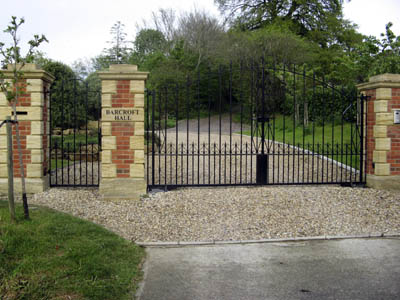
The gates at Barcroft Hall
A determined walkers’ champion has won a six-year legal battle to have gates removed from a path at a Somerset mansion.
In a High Court judgement, Justice Cranston ruled that gates across Barcroft Lane at the £3.8m Barcroft Hall at South Petherton must be removed. The case was brought by campaigner Peter Kidner, backed by the Open Spaces Society.
The outcome was described by OSS general secretary Kate Ashbrook as a landmark ruling with wider significance for footpath campaigners.
Barcroft Hall owner Brian Herrick erected the gates after buying the property in 2001.
Following a 2006 case in which he was found guilty of obstructing a public right of way, Mr Herrick unlocked the gates, but Mr Kidner launched a legal action to force Somerset County Council to act to have the unlawful obstruction removed.
Magistrates backed Mr Kidner, and at a subsequent Crown Court hearing, Mr Herrick won a partial victory when the court ruled that the gates and the middle pillar be removed, but that the outer pillars and flywalls could remain.
Unsatisfied, Mr Herrick appealed the decision, but today, High Court judge Mr Justice Cranston dismissed the appeal. The county council must now enforce the removal of the gates in their entirety.
Mr Kidner’s case was to prove the gates ‘significantly interfered with the exercise of public rights of way over that way’. For some time they were locked but, he said, even when they were open, they were a psychological barrier to the public.
Turning down Mr Herrick’s appeal, the judge said: “in my judgement the public is entitled to use and to enjoy everything which is in law part of a footpath.
“The Barcroft Hall gateway prevented public passage and the enjoyment of amenity rights over [the] footpath.
“There is no reason to confine interference to physical interference. An object can get in the way of the right of passage or other amenity rights because of its psychological impact.”
Kate Ashbrook said: “This is a landmark ruling. It shows that the whole width of the public highway must be available for public use. No longer can landowners and occupiers get away with filching parts of the highway; the highway authority has a legal duty to protect the public’s rights over the whole highway.’
“We congratulate Peter Kidner for his courage and persistence, and his legal representatives for their eloquent legal arguments. They have made a massive difference in clarifying the law for walkers, riders and other path users, to enable us to get illegal obstructions removed from the highway and to exercise our rights fully.”
Last week, Mr Herrick told thisissomerset.co.uk he would stand up to ‘extremists’ who were souring relationships between him and his wife Denise and local walkers.
He said: “We don’t stop people walking on our land, we promote it.
“Being ramblers ourselves we feel an extremist is ruining the relationship between landowners and walkers. We have an excellent relationship with walkers and we have a lot of support.”
He said he faced a £200,000 legal bill if he lost the case. However, Mr Herrick said he had applied to Somerset County Council to have the footpath removed from the definitive map, because he believed it may not be a public right of way.
Mr Herrick told grough: “We are surprised, shocked and distressed by this judgment. It has huge implications for every farmer and landowner in the country and for every cash-strapped local authority that could now be forced to fight expensive and lengthy court cases that it can ill afford. We are currently taking advice and considering our position.”
Edward Etherington
19 February 2010It's almost laughable how this type of transgressor tries to label someone dedicated to getting the law complied with, for the benefit of the public, as an "extremist". Surely, if anyone, it's actually Mr. Herrick who is the extremist. Trying every tactic, one after the other, to win the right to keep these structures which are in no-one's interests other than his own. This latest tactic has rather an air of desparation about it: trying to claim that it's not even a right of way. Come on!
It is the Kidners of this world who are the real friends of public path users, not the Herricks. If Mr. Herrick genuinely cared about "ramblers" then he would have removed the structures of his own accord, a long time ago. The author of his own fate, he deserves to have to pay every penny of that £200,000 legal bill.
He's right about the judgement having "huge impliactions", though. Landowners who are wilfully obstructing highways, or parts of highways, should at last start to get the message that this has to stop, and the case should actually make it easier for "cash-strapped" local authorities to get them to remove obstructions.
It will have no implications, though, for the law-abiding landowner or farmer who treats public paths, and the laws which protect them, with respect. Section 147 of the Highways Act 1980 even provides a framework whereby appropriately dsigned structures, such as gates and stiles that are genuinely needed for agricultural purposes, can be officially authorised by local authorities.
Yes, a hugely important case, and very much the right result.